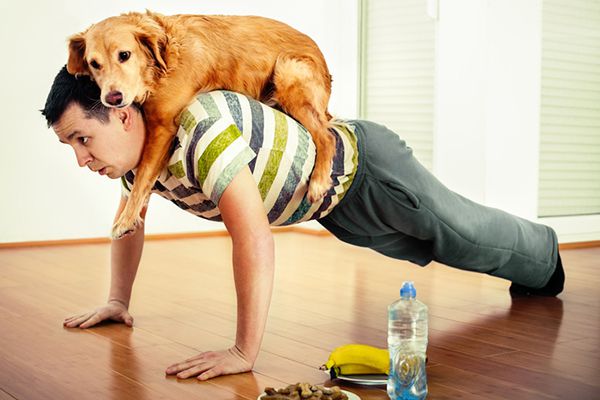Does your older dog do exercises?
Remember when he was busy and active?
Think back to your dog’s younger days, when he would race after Frisbees and chase down a tossed ball. You just knew he was happy and healthy.
No matter how old he is, when a dog is active and stimulated it’s good for his overall well-being: physically, mentally and emotionally. In fact, exercise is the very thing a dog needs to maintain his quality of life as he ages.
What if he’s out of shape?
If your dog has been off the “training circuit” for a while, he isn’t going to be ready to walk all the way downtown and back. Understandably, extreme exercise is not healthy (or desirable) for a dog that has been sedentary for a long time.
If he’s overweight, it’s especially hard on his aging body – that extra weight is tough on stiff joints and sore muscles. This length of time does however depend on the type of dog. Regardless, check with your vet before introducing him back to regular exercise.
Bow-wow-Ow!
Commit to a daily exercise routine, but since he’s older, start off slowly. Take him for two short walks each day, starting with one or two blocks and add on as he gets more comfortable with it. Warm him up for 5 minutes, walking at a leisurely pace, then walk briskly for 15-20 minutes and cool him down for another 5 minutes. Or he may have developed arthritis, heart disease, diabetes or hip dysplasia. A short legged dog or toy dog cannot handle the same amount of exercise as a larger more naturally athletic canine. Also, remember to be cautious about the temperature for Brachio-cephalic breeds.
Don’t push him too hard. He’ll tire more easily now that he’s older. Plus, he’ll want to please you and keep up with your pace, even though he might start to feel pain or get overheated and dehydrated. So keep an eye on him and watch for signs of discomfort, like favoring a leg or paw, being excessively out of breath or slowing down or stopping. If so, give him a break, along with some water, love and encouragement.
Dog-friendly paddling is his kind of exercise.
Swimming is probably the best exercise for most aging dog’s. Canine swim therapy is a popular option for dogs with joint or heart conditions, because it provides a good aerobic workout with a full range of motion while supporting the body and putting little weight on the joints.
Games? Toys? Kibble?
Another good option is to get him moving in the comfort of his own home. Take him personal to the Rec room and get him playing with one of his at-home toys. Play “Fetch-lite”, “Treasure Hunt” or “Keep Away”. Or fill one of his Kong toys with kibble and let him work away on it so that he can stand, exercise his jaw muscles and have a tasty treat at the same time. Fun at home will keep him active and he won’t resort to just lying around when he’s bored.
By Dog Care Tip





0 Comments